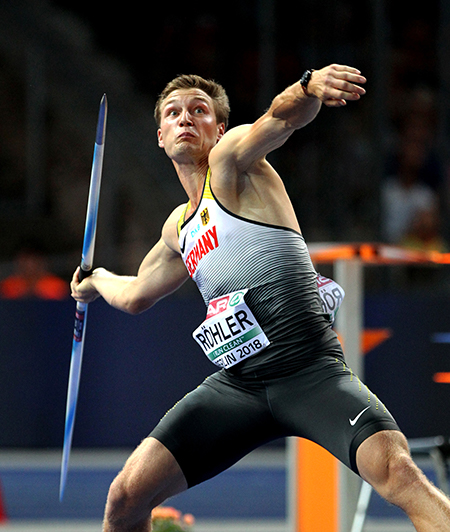
It’s rare in a continental championship that the top 3 in the world in one event come together to decide who is best. It’s rarer still that all three should be from the same country. Rarer than that? That the championship is held in their home country. The hoped-for German men’s javelin-medal sweep did not materialize at Berlin’s Olympiastadion, but the national team finished a still notable 1-2-5.
The places were decided early. On a hot and humid night replete with swirling wind and heavy air, the expected 90-meters-plus (c295ft) fest did not materialize. Olympic gold medalist Thomas Röhler, the most consistent of the trio, came closest to 90 and won with his third-round 293-6 (89.47) heave. Andreas Hofmann’s 287-5 (87.60) second-stanza toss led until Röhler flew by him a round later.
Estonia’s Kirt Magnus (282-0/85.96) and Poland’s Marcin Krukowski (277-4/ 84.55) broke up the sweep. The top 4 were decided in the first 3 rounds as throwing conditions deteriorated. Reigning world champ Johannes Vetter, the third German, mustered a best of 273-2 (83.27) and simply could not get unwound as he ended up far from his’18 world leader of 304-1 (92.70).
Röhler was the only one who had a successful strategy for handling the wind. In separate individual interviews Röhler and Hofmann revealed the subtle difference between gold and silver. “The wind was difficult,” said Röhler, “but we expected that—or I expected that—and I had a game plan for today: just throw precisely, no power, nothing. Just do what you can do as precisely as you can. All the throws showed it was possible, but it was really tough to make them sail.” As he said “precise,” Röhler pinched his thumb and forefinger together, raised his arm, and pointed to the sky to exactly the point he was aiming for. The changing nature of the wind was a factor, too, he explained: “People in the stands told me it was a headwind; we just felt a strong tailwind—I think we just felt it at different levels.”
Runner-up Hofmann said, “Sometimes it was from the back and sometimes from the side and after the second throw I don’t know. I hit the point—I hit the javelin very well the first few meters, but then when the javelin got its height it came down very, very early—too early. But it was not a technical thing—the throw was very good but I don’t know what happened in the air. Some dealt with it better than me. It was a struggle, and you see it was 2m farther,” he said ruefully of Röhler’s winner.
When asked if it would be helpful to have a directional wind gauge, Hofmann said that one on the ground would only be a beginning. “You throw 30, 40m higher—you have to have a wind gauge there or flags or something like that. Sometimes you see it in the stadium,” said the always shrewd silver medalist. “On the roof you see some flags and then you can deal with it—how the wind goes 10–12m faster.” How to use this information? “Before the competition you can deal with the struggle of how you want to throw.”
It was Röhler who figured out best how to handle the wind, and his precision won the day. □